Abstract
Seawater desalination is considered a technique with high water supply potential and has become an emerging alternative for freshwater supply in China. The increase of the capacity also increases energy consumption and greenhouse gases (GHG) emissions, which has not been well investigated in studies. This study has analyzed the current development of seawater desalination in China, including the capacity, distribution, processes, as well as the desalted water use. Energy consumption and GHG emissions of overall desalination in China, as well as for the provinces, are calculated covering the period of 2006–2016. The unit product cost of seawater desalination plants specifying processes is also estimated. The results showed that 1) The installed capacity maintained increased from 2006 to 2016, and reverse osmosis is the major process used for seawater desalination in China. 2) The energy consumption increased from 81 MWh/y to 1,561 MWh/y during the 11 years. The overall GHG emission increase from 85 Mt CO2eq/y to 1,628 Mt CO2eq/y. Tianjin had the largest GHG emissions, following are Hebei and Shandong, with emissions of 4.1 Mt CO2eq/y, 2.2 Mt CO2eq/y. and 1.0 Mt CO2eq/y. 3) The unit product cost of seawater desalination is higher than other water supply alternatives, and it differentiates the desalination processes. The average unit product cost of the reverse osmosis process is 0.96 USD and 2.5 USD for the multiple-effect distillation process. The potential for future works should specify different energy forms, e.g. heat and power. Alternatives of process integration should be investigated—e.g. efficiency of using the energy, heat integration, and renewables in water desalination, as well as the utilization of total site heat integration.
1. Introduction
Increasing water scarcity has become a global issue. Freshwater supply is limited and has been remarkably affected by the degradation of water quality in natural water bodies, while the demand for freshwater has continued to increase. Besides water consumption minimization by improving water use efficiency, conventional water treatment and desalination are employed to reclaim the polluted water and freshwater to increase the supply. Especially in water-scarce regions, where the water source is mainly from precipitation, the water supply has been unreliable due to the influence of global climate change [1]. Water desalination has been widely applied in the world. A report from the Water Desalination Report by the International Desalination Association presented the current installed capacities of the world desalination by countries [2]. Figure 1 shows the water desalination capacities of the world by countries from 2010 to 2016 [2]. In the last six years, the world total water desalination capacity, including brackish water and seawater desalination, increased steadily with an annual rate of about 9%. A large proportion came from the Gulf region, and not surprisingly, the Kingdom of Saudi Arabia (KSA) and the United Arab Emirates (UAE), which take a proportion of 15% and 11% of the world's total desalination capacities in 2016. Next is the USA, which takes 10% of the world total installed desalination capacity. China has the fourth largest water desalination capacity, with a share of 5% of the world total installed capacity.

Figure 1.
Water desalination capacities of the world and selected countries from 2010 to 2016 (derived from [2]). KSA: Kingdom of Saudi Arabia; UAE: United Arab Emirates.
Water desalination is an energy intensive approach for freshwater production [3], and the rapid increase of installed capacity has resulted in increasing resource (mainly energy) consumption and environmental impacts. Based on the water desalination capacities and the energy consumption factor provided by [4], the energy consumption of the world overall water desalination is estimated and as shown in Figure 2.

Figure 2.
Water desalination energy consumption (electricity) from 2010 to 2016.
The environmental impact of water desalination has been focused on theoretical and scenario analyses [5]. Cornejo et al. [6] found that reverse osmosis (RO) technologies have lower GHG emissions than thermal desalination technologies. The estimated GHG emissions footprint of seawater RO desalination (0.4–6.7 kg CO2eq/m3) is generally larger than brackish water RO desalination (0.4–2.5 kg CO2eq/m3) and water reuse systems (0.1–2.4 kg CO2eq/m3). Shrestha et al. [7] determined that the associated CO2 emissions for seawater desalination (0.25 Mt/y) are 47.5 % higher than that for water conveyance (0.17 Mt/y). The GHG footprint values vary due to the variability of location, technologies, life cycle stages, parameters considered, etc.
For producing freshwater, seawater desalination has been strongly implemented in the Gulf region and is emerging in East Asia, where are facing serious water stress issues. China has the fourth largest capacity of seawater desalination in the world, and water desalination is still an emerging industry. The major driving force is increasing water shortage. China is becoming one of the countries with a severe water shortage especially in the most developed northeast region [8]. For example, in 2016, the average water resource per capita was 2,355 m3 [9], which is about 40% of the world average value [10]. For the capital city of China, Beijing, the amount is 162 m3 [11], which is less than 3% of the world average value. The population and urban land in these water stress areas are still increasing [8], which indicates an increasing demand for freshwater. One fact is that about 71% of the Earth's surface is covered by water, and the oceans hold about 96.5% of all Earth's water [12]. Consequently, the water shortage is a shortage of clean freshwater, which will lead to an increase in economic cost and resource consumption, as well as potential environmental impacts.
Facing the water shortage issue, China is making a major effort with increasing the water use efficiency and eliminating water waste. On the other hand, for the regions with severe water shortage, there are mainly two possibilities to increase the amount of available freshwater. One solution is water transfer projects, including the South–North Water Transfer Project and the Water Transfer from Yellow River to Qingdao Project [13]. These projects are carried out by constructing water channels to transfer freshwater from water-rich areas to water-scarce regions, mainly Beijing, Hebei, Henan, and Shandong. Another action is the promotion of seawater desalination techniques and projects. From 2006 to 2016, the installed seawater desalination has increased from 20 × 106 m3/y to 390 × 106 m3/y [14]. Until 2016, there have been 15 newly released standards by the government to facilitate the promotion and management of water desalination projects [14]. Seawater desalination has been considered as one of the most promising techniques due to the abundance of seawater and the improving operating efficiency [15]. With an increased capacity, the potential of resource consumption and environmental impacts are also concerned.
The majority of studies have focused on either the advancement of the desalination process or specific case plants. Sores et al. [16] proposed and tested a novel supercharger which can be applied to a seawater desalination RO system and found that the efficiency of the tidal supercharger is currently lower than 20%, although the efficiency increased from 12% to 14%, with the seawater flow rate increasing from 290 m3/h to 440 m3/h. The application of renewable energies is also discussed in the current studies. For instance, Zuo et al. [17] proposed a model of a wind supercharged solar chimney power plant combined with seawater desalination and claimed that the utilization of solar energy can be raised by 70% with integration. Li et al. developed a high-efficiency membrane for seawater desalination using solar energy [18], and the results showed a 90% efficiency of converting solar energy. Desalination plants in China have seldom been discussed. Liu et al. [19] carried out the systems process analysis of the freshwater cost of seawater desalination, with a case study of a 25,000 m3/d seawater desalination plant in Huanghua Port, Hebei Province, China. The study determined that the freshwater consumption of the plant is 4.5 × 105 m3/y, which is 5% of the annual freshwater production (9.2 × 106 m3/y). The World Resources Institute [15] investigated the carbon footprint of different scenarios in Qingdao. It showed that in 2020 with a water desalination capacity of 400 × 103 m3/d, the carbon footprint of the water desalination will be 541.31 kt CO2eq/y (with a cost of 8 CNY/m3), which is 1.81 times more expensive than water supplies from surface and groundwater (with a cost of 1.17 CNY/m3). Other studies also reported that water desalination with various techniques has other atmospheric emissions, e.g. dust, NOx, and SOx [20].
Most of the literature have focused on either the advancement of the desalination process or the specific case plants. The overall picture of the development and environmental performance, as well as the cost of seawater desalination in China, has not been thoroughly discussed. There is an urgent need to analyze the current development of the seawater desalination in China and to benchmark the energy consumption, emissions, as well as the cost. This can provide an overall picture of the environmental and economic performance, and facilitate energy consumption minimization, GHG reduction, and efficiency improvement in seawater desalination implementations. The aim of this paper is to provide fundamental remarks for the further studies of the water-energy nexus of seawater desalination. In order to do this, the paper first overviewed the current development and processes of seawater desalination projects in China. Then, the energy demand, GHG emissions, as well as the unit product cost of the seawater desalination plants were estimated. Based on the calculation, the future development and promising directions of water desalination studies are discussed.
2. Seawater Desalination in China
With the promotion and development of water desalination projects and more advanced technology, the total capacity of seawater desalination plants increased from 20 × 106 m3/y to 390 × 106 m3/y from 2006 to 2016, which can be seen from Figure 3 [14]. Due to the introduction of relevant policies and standards by the government, seawater desalination has been one of the promising solutions to the water shortage in China.
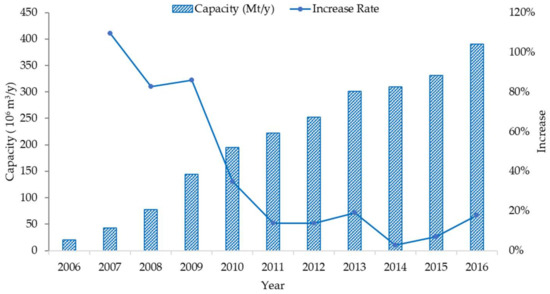
Figure 3.
Total seawater desalination plant capacities in China from 2006 to 2016 (Based on [14]).
According to the State Oceanic Administration of China [14], there have been 131 seawater desalination plants/projects up until 2016 in mainly coastal cities in China, and the total capacity has reached to 1.19 × 106 m3/d. The plants with different capacities are evenly distributed.
As shown in Table 1, there are 36 plants/projects with a capacity larger than 10 km3/d, with a total capacity of 106 m3/d. 38 plants have a capacity of 103 m3/d to 104 m3/d, with a total capacity of 1.2 × 105 m3/d. Another 57 smaller plants/projects have a total capacity of 1.1 × 104 m3/d. The largest water desalination plant in China is in Tianjin, with a total capacity of 2 × 105 m3/d.

Table 1.
Water desalination projects development in China until 2016 (Based on [14]).
Regionally, large-scale seawater desalination plants are located on the northeastern coast of China with relatively severe water scarcity issues, e.g. Tianjin, Shandong, and Hebei. Figure 4 shows the seawater desalination capacities of the plants by desalination process, as well as the estimated water stress index of the provinces with seawater desalination plants. Tianjin, as a coastal city next to Beijing (the capital of China), has the largest total capacity of 317 × 103 m3/d, with RO and multiple-effect distillation (MED) being the main processes, multi-stage flash (MSF) and electrodialysis (ED) are less applied in China. The Tianjin Beijing seawater desalination plant, with a capacity of 200 × 103 m3/d, is the largest seawater desalination plant in China. Tianjin also has the largest installed seawater desalination plants with MED process. Shandong has the second largest seawater desalination capacity (282 × 103 m3/d). The largest water desalination plant in Shandong is located in Qingdao, an international city facing severe water shortage issues, with a capacity of 105 m3/d. The total capacity of water desalination plants in Qingdao reached 235× 103 m3/d in 2016, which takes 83% of the total capacity of Shandong province [21]. One large-scale plant in southern China is in Zhejiang Province, with a capacity of 228 × 103 m3/d. Other seawater desalination plants in southern China (e.g. Guangdong, Fujian, Jiangsu, and Hainan) are mainly small plants. Most of the plants are built after 2009, and the main processes applied are reverse osmosis (RO, with a proportion of 86%) and MED (with a proportion of 12%). Other technologies such as MSF and ED are also applied in few plants, with a total ratio of 2%.
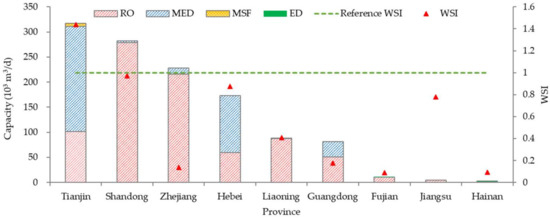
Figure 4.
Water desalination capacity by provinces (derived from [14]). WSI: water stress index, RO: reverse osmosis; MED: multiple-effect distillation; MSF: multi-stage flash; ED: electrodialysis.
Figure 4 also indicates that the provinces/cities with large seawater desalination plants also have a higher water stress index (WSI), which is the ratio of the annual water consumption and the available natural water resources [22]. A higher WSI indicates that consumption is closer to the available water resources, thus higher water stress. When the value is higher than 1, it means the water consumption of the region has exceeded the available freshwater resources, and the region has a high water stress level. The WSI of the selected provinces are estimated with the method of [22] based on the data from [9], and the values are shown in Figure 4. The green dash line is the reference WSI with a value of 1. For most of the selected provinces, provinces with higher water stress have higher seawater desalination capacity, which indicates the driving factors of the development of seawater desalination. Two exceptions are Zhejiang and Jiangsu. Zhejiang has the third largest seawater desalination capacity, but the water stress is rather small. Jiangsu has a very small seawater desalination capacity but with relatively high water stress.
In terms of water use, as shown in Figure 5, a major proportion (66.6%) of desalted water is used in industries, and followed by domestic use with a ratio of 33.1%, and a small fraction (0.3%) is used for other purposes, e.g. watering in parks and greenbelts. Within industry, main users of desalinated water are fossil fuel power plants (31.6% of total), steel making industries (13.1%), and petrol chemical industries (12.3% of total). The major use in industries indicates that the quality of the desalted seawater needs to meet the quality requirement for industrial use.
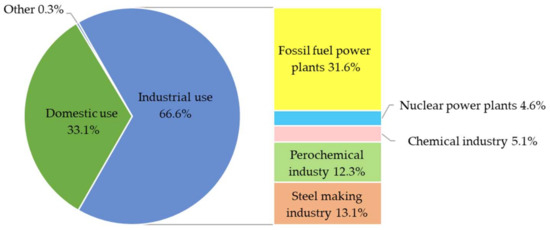
Figure 5.
Distribution of desalinated water use in 2016 (Based on [14]).
Water treatment, seawater desalination, and water resource transfer are the main solutions for the freshwater shortage in China. Wastewater treatment, as the most conventional approach, has been well developed and implemented. The wastewater treatment approach can only offset part of the consumed water by removing the contaminants from the polluted water and return the treated water back to the available natural resource, but usually, the water quality of the discharged water is not as high as previous. When there is not enough available natural water resource, the cycle of supply- use-treatment-return cycle would be difficult to maintain. Water transfer is usually a huge project that has considerable economic and ecological cost, with large-scale changes to the inhabitants along the channel. Due to this reason, the existing water transfer projects in China are still under controversial discussion [23]. Seawater desalination is considered as one of the most promising approaches to produce freshwater.
Although seawater desalination is a reliable water supply and is not vulnerable to climate change, it consumes a lot of energy and it requires a lot of investment and public acceptance. The increasing capacity and wide distribution in different regions also result in the issue of increasing energy consumption, GHG emissions, as well as the economic cost. It is important to analyze and benchmark the environmental and economic performance, in order to provide insightful data for the further planning and optimization of energy use and emission reduction in seawater desalination.
3. Methodology
The energy consumption, GHG emission, and the unit product cost of the seawater desalination plants in China are assessed for the year of 2006–2016. The seawater desalination capacity data of China overall and selected provinces in 2016 are mainly derived from [14], and other data sources are explained where mentioned.
3.1. Energy Consumption
The energy consumption of seawater desalination plants in China can be calculated using mass balance equations along with the specific energy consumption (SEC) and the capacity of the plants. SEC in kWh/m3 desalinated water, is one of the most critical factors characterizing the performance of the water supply [24].
where is the annual energy consumption of the plant, kWh/y; SECi is the specific energy consumption of seawater desalination plants with process i, kWh/m3; the energy consumption of all desalination processes involved in this study (RO, MED, MSF, and ED) are converted to the form of electricity, kWh/m3; is the capacity of the desalination plants with process i, m3/d. Pa is the availability of the plant, when specific data is not available, Pa is set as 90% based on the study of [25].
The specific energy consumption of various desalination processes is listed in Table 2.

Table 2.
Specific energy consumption (SEC) of different processes (based on [4]).
3.2. GHG Emissions
Since there are no major direct GHG emissions in water desalination, the estimation of GHG emissions mainly considers the emissions from energy consumption. The estimation method is based on the calculation method of GHG emission from processing proposed by ISCC [26], which is shown as follows:
where Ge is the annual GHG emissions of the desalination plants, t CO2eq/y; is the emission of energy consumption, t CO2eq/y; is the emission of material inputs, t CO2eq/y; and , is the indirect emission from treating the waste generated from the desalination processes, t CO2eq/y. In this study, the GHG emission from energy consumption is estimated, and the emissions of material input (seawater) and waste (brine) are not considered due to the limit of data availability.
where is the annual energy consumption of process i, kWh/m3; and Ef is the emission factors, t CO2eq/kWh. In this study, the Ef is set as 1.04 t CO2eq/kWh according to the reference [27].
3.3. Unit Product Cost
The cost of water desalination mainly includes capital cost and operating cost, with the later mainly consisting of energy cost for plant operation and the cost for maintenance. In this study, the unit product cost, which is the cost per m3 desalted water, is calculated based on the method proposed by [25].
Estimation of the unit product cost is calculated as follows:
where UPC is the unit product cost, USD/m3; CC is the capital cost of the plant over the lifespan, USD; Pl is the plant life, y; OPa is the annual operating cost; USD; Ca is the capacity of the plant, USD; Pa is the plant availability, %.
Capital Cost
The capital cost is calculated according to the power law rule:
where CCx and Cax are the capacity (m3/d) and capital cost (MUSD) of the studied plant; CCrf and Carf are the capacity (m3/d) and capital cost (MUSD) of the reference plant, m is the power value.
Consequently, the capital cost of plant x can be calculated as:
According to [25], m is set as 0.8 for seawater desalinate plants. A dataset of the year 2016 from the Carlsbad Desalination Plant, in San Diego County, USA, is selected as the reference plant to estimate the overall capital cost of the desalination plants (shown in Table 3).

Table 3.
Basic data of the Carlsbad Desalination Plant, in San Diego County [25].
Operating Cost
The annual operating cost includes the energy consumption (electrical power), maintenance, labor, membrane replacement, as well as the cost for the chemicals. The operating cost is dependent on the operating process of the desalination plants, but in general, energy cost is the major component. Zhou et al. [28] studied the cost of thermal processes and found that energy cost is 87% of the total operating cost.
Wittholz et al. [25] investigated the cost of water desalination, and analyzed the breakdowns of the cost, including fixed cost (capital cost) and operating cost (maintenance, material and energy cost, etc). The contribution of the energy cost to operating cost is also estimated (Table 4).

Table 4.
Average cost breakdowns of different desalination processes (based on [25]).
The operating cost can be calculated with energy cost and the energy/operating cost ratio as in Equation (7):
where OPa is the annual operating cost, MUSD, Eco is the energy cost, MUSD, and EOP is the ratio of energy cost and operating cost, %, which is shown in Table 4.
The cost of energy consumption can be calculated based on the specific energy consumption of different processes and the capacity as well as the price of the electric power, as shown in Equation (8):
where SECi is the specific energy consumption, kWh/m3; the energy consumption of all desalination processes involved in this study (RO, MED, MSF, and ED) is converted to the form of electricity, kWh/m3; Pe is the price of the electricity supplied for desalination plant, USD, the price is estimated for the year of 2016.
The electricity price for water desalination plant is referred from reference [29]. The cost is estimated from water input to the gate of the plant; water conveyance and distribution, as well as the brine disposal are yet considered.
4. Results
4.1. Energy Consumption and GHG Emissions
The energy consumption and GHG emissions of the Chinese seawater desalination are determined for the period of 2006–2016 (Figure 6). The annual energy consumption increased in the 11 y from 81 MWh/y to 1,561 MWh/y, with an increasing rate of 182%. The GHG emissions increased from 85 MtCO2eq/y to 1,628 MtCO2eq/y.
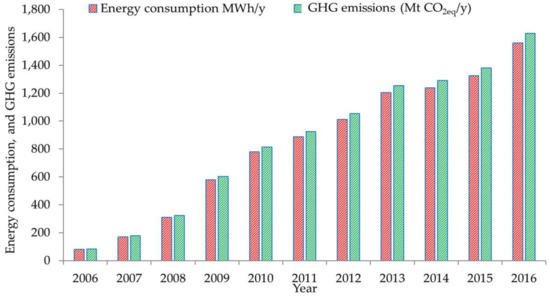
Figure 6.
Overall seawater desalination energy consumption and GHG emissions from 2006–2016.
The breakdowns of GHG emissions by province and desalination processes are estimated for the year of 2016, as shown in Figure 7.
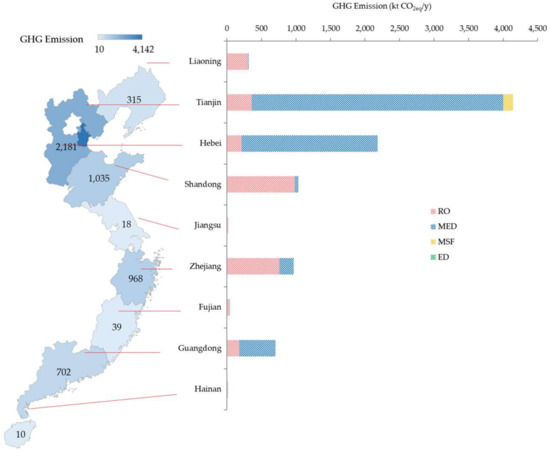
Figure 7.
GHG emissions of seawater desalination: Regional distribution and breakdowns by processes.
The map in Figure 7 showed the east costal line in China and marks the provinces with seawater desalination plants. The deeper color indicates higher provincial seawater desalination GHG emissions. The total GHG emissions of the seawater desalination plants in China in 2016 are 9,409 MtCO2eq. The provinces of Tianjin, Hebei, and Shandong are the middle three contributors. The GHG emissions of these three provinces are 7,359 MtCO2eq, which is 78.2% of the total seawater desalination GHG emission in China. Regarding the desalination process, MED plants contribute the most to the GHG emissions. Tianjin has the highest GHG emissions of 4,142 MtCO2eq in China, and the MED plants contributed more than 88.0% (3,645 MtCO2eq) of the total seawater desalination GHG emissions of Tianjin. This is a major contributor to the overall emissions of all seawater desalination plants in China in 2016. Shandong Province has the second largest seawater desalination capacity, but the GHG emissions are much lower (1,035 MtCO2eq) compared to Hebei, which has larger emissions (2,183 MtCO2eq) with smaller desalination capacity. The main reason is that the seawater desalination plants in Shandong are all RO plants. For Hebei Province, about 65% of the total desalination capacity is MED, which is more energy and GHG emission intensive. On the other hand, the south part of China has relatively lower GHG emissions, due to a smaller capacity and less energy intensive processes.
4.2. Unit Product Cost
The Unit Product Cost (UPC) is correlated with the desalination processes and the capacity of the plant, the type of energy used for the plant, etc [30]. In this study, the energy consumptions of all processes are converted to electricity, therefore the impact of energy source is not analyzed. The UPC of seawater desalination plants in different provinces in 2016 is determined as shown in Figure 8, and the desalination process is specified.

Figure 8.
Unit product cost of water desalination by province in 2016.
The UPC of RO desalination plants shows a slight difference. Firstly, the UPC of MED, MSF, and ED is much higher than RO, which is inconsistent with the conclusion of other studies. For example, a case study of Qingdao [14], Shandong Province, China showed the average economic cost of seawater desalination process is 8 CNY/ m3 (approx. 1.16 USD based on the current exchange rate 0.15), with an RO plant capacity of 3 × 103 m3/d. Hainan has the highest UPC for RO seawater desalination of 1.3 USD, Shandong and Zhejiang have the lowest UPC for RO seawater desalination of 0.8 USD. For MED seawater desalination, Hainan has the highest UPC of 3.6 USD, while Tianjin has the lowest UPC of 2.0 USD. The only province with MSF process, Tianjin, has a UPC for MSF desalination of 3.0 USD. The UPC for ED process desalination of Fujian and Hainan are 1.9 and 1.7 USD. It can be seen that for different processes, the UPC in increasing order is RO < MED < ED < MSF, with RO as the cheapest and most applied desalination process. For the same process, the price varies within a reasonable range, e.g. the UPC of RO process desalination plants in the selected provinces in increasing order are: Shandong = Zhejiang < Tianjin = Hebei = Liaoning = Guangdong < Fujian < Jiangsu < Hainan.
5. Discussion and Future Directions
5.1. Discussion
Seawater desalination has high water supply potential, but high energy consumption, GHG emissions, and cost. Water desalination has a considerable water supply potential due to the abundance of its water source, and the desalination technology is improving. On the other hand, this type of water supply is still supported by higher cost and intensive energy consumption and GHG emission. Even though the cost and energy use are decreasing [7], seawater desalination is still an energy intensive and costly approach compared to other freshwater alternatives. The World Resources Institute investigated the energy consumption of water desalination plants in Qingdao, Shandong province in China. The results showed that electricity is the main energy used for water desalination [15], and the SEC of different water supplies are shown in Table 5.

Table 5.
Energy demand and water supply potentials of water supply alternatives (from [15]).
It showed that for the various water supply alternatives, surface water has the lowest energy demand for per unit water (about 10% of seawater desalination), and at the same time with the lowest water supply potential (37% of seawater desalination). On the other hand, seawater desalination (RO process) has the highest energy demand with the highest water supply potential. For other desalination processes, the energy demand is even higher.
This indicates that with the current situation of techniques, water desalination is still an option with higher cost. Considering the continuously increasing population and the demand for freshwater, seawater desalination has the potential of providing a stable amount of fresh water and should be viewed as a crucial component in the future development of non-conventional water supplies [31]. The energy demand and thus GHG emissions are highly related to the capacity and techniques applied in the plant [30]. The study of [4] showed that for a water desalination plant with capacity from 5 to 15 m3/d, the total electricity consumption would vary from 14.45 to 21.35 kWh/m3, and the MED process has the highest energy demand, which is inconsistent with the results of this study (Figure 8). This indicates the potential for energy consumption and GHG emission reduction can be optimized with improving the combination of capacities and processes. According to the results of [14], a case study of Qingdao, the overall cost of different water supplies from the lowest to the highest are local surface water < groundwater < reclaimed water < brackish water desalination < seawater desalination. Seawater desalination is still currently a more expensive approach for producing freshwater compared to other water supply alternatives.
Determining the energy consumption, GHG emissions, as well as the cost of seawater desalination would be helpful to identify the potential of improving the energy efficiency and productivity of seawater desalination. New and advanced technologies, e.g. low energy reverse osmosis membranes, improved energy recovery devices, highly energy efficient pumps, and optimized pre-treatment systems, can enhance the energy efficiency of seawater desalination. The application of energy recovery units in the desalination processes can also highly increase the energy use efficiency [3]. Increasing the efficiency of the process and the application of energy recovery system will reduce its energy consumption and thereby its CO2 emissions.
The energy consumption, GHG emissions, and the cost of seawater desalination in China are higher than the average values of the major desalination contributors in East Asia, e.g. Singapore. Singapore has the second largest seawater desalination capacity of 0.45 × 106 m3/d [32], which is 36% of the seawater desalination capacity of China. The average UPC of the two large scale RO seawater desalination plants is 3.5 kWh/m3 and the cost is estimated as 0.75 USD/m3 [33], and the price is estimated to increase due to the higher price of energy. The energy consumption and cost of per m3 desalinated water in Singapore are lower than in China. However, as these indicators are affected by the specific process, type, quality, and price of the energy, as well as the location of the plants, etc. The comparison between different countries would be limited to provide insightful information, but a comprehensive analysis of different water supply alternatives, or different desalination processes in the same region would facilitate regional water use management.
5.2. Future Works
The correlation between the UPC and the capacity needs further investigation. In this study, the UPC and capacity of seawater desalination plants showed a very obvious correlation. Identifying this correlation would be helpful for the optimization of seawater desalination. Figure 9 showed the trend line of the UPC-availability plots. As MSF and ED are rarely applied, there is not enough sample data, and only RO and MED are discussed. For RO plants, the correlation between the UPC and the capacity fits the logarithmic correlation with a R2 of 0.9847 and 0.9359 for MED plants.
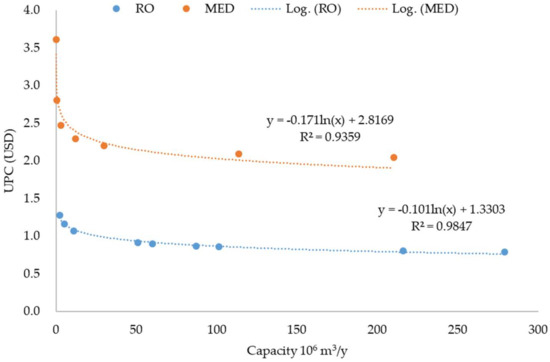
Figure 9.
The correlation between unit product cost (UPC) and the seawater desalination capacity.
The figure showed a decreasing UPC with the capacity increasing. According to a statistic of China seawater desalination [14], in 2016, large plants (capacity > 104 m3/d), the average cost is 6.22 CNY/m3 (0.90 USD), and the average of desalination cost in medium plants (104 < capacity < 103) is 7.20 CNY/ m3 (1.05 USD). In this study, Shandong has the lowest UPC (0.8 USD) with the highest RO capacity of 0.28 × 106 m3/d. Following is Zhejiang, with the same UPC and a RO capacity of 0.22 × 106 m3/d Tianjin. For MED the trend is not clear. The correlation analysis between the capacity and the UPC should be further investigated with more sufficient data.
Potentials for energy consumption and GHG emission reduction in seawater desalination. The water-energy integration in seawater desalination, e.g. seawater desalination plants utilizing renewable energy [34], low potential heat integrated with seawater multiple-effect thermal desalination [35], which are worth further investigation. The implementation of the integration of energy and seawater desalination still needs a comprehensive review.
In addition to energy consumption and GHG emission, there are other potential environmental issues of seawater desalination. Along with the desalted seawater, a remarkable amount of brine is also produced from the process. A common approach is currently to dispose the brine back to the sea, which might cause harm to the regional aquatic life due to high salinity [36]. The utilization and treatment technologies of the brine is still. Similarly, chemical and thermal pollutions in the near-plant areas, should be further investigated in the future works.
A limitation of this work, which should form the potential future works, is less investigation of the energy consumption by different forms of energy, e.g. heat and electricity in different processes. The usage of renewable energies should also be further reviewed. To cover the whole life cycle, the waste generated during the desalination process, including brine, wastewater, and waste heat should be investigated.
6. Conclusions
Seawater desalination is an emerging approach for producing freshwater in China, and the number of plants, as well as the installed capacity, are increasing. Simultaneously, the energy consumption, and environmental impacts are also increasing. This study initially investigated the energy consumption, GHG emission of the seawater desalination in China from 2006 to 2016, and the unit product cost in 2016. The key findings and conclusions are:
- (1)
- With the increasing installed capacity of seawater desalination from 2006 to 2016, the energy consumption and GHG emission increased from 81 MWh/y to 1,561 MWh/y during the 11 years. The overall GHG emission increase from 85 Mt CO2eq/y to 1,628 Mt CO2eq/y, with an increasing rate of 180%. Tianjin has the largest GHG emissions, followed by Hebei and Shandong, with emissions of 4.1 MtCO2eq/y, 2.2 MtCO2eq/y. and 1.0 MtCO2eq/y.
- (2)
- The unit product cost (UPC) of seawater desalination is higher than other water supply alternatives, and it differentiates the desalination processes. The UPC of the RO process varies from 0.8 USD to 1.3 USD in 2016, and the UPC of MED, MSF, and ED are 2.0 USD–3.6 USD, 3.0 USD, and 1.7 USD to 1.9 USD. Tianjin which has the largest overall seawater desalination capacity has the relatively lowest UPC for RO and MED.
- (3)
- Seawater desalination is now being highly encouraged and developed in China and is becoming a critical water supply alternative for cities with serious water scarcity. The cost, energy demand and GHG emissions are still considerably higher than surface water supply. There is potential for energy consumption, GHG emission and cost reduction with the application of energy recovery units, the integration of desalination plants and renewable energies or low potential heat, as well as the development of new technologies.
Limitation of this work, and also the potential for future works are, (1) Energy consumption should specify different energy forms, e.g. heat and power. In this study, due to the limit of data, the energy used in different processes are converted into electricity. But it is necessary to investigate different energy forms for a more detailed analysis, and the cost analysis would be more accurate. (2) When data is available, the capital cost of the plants should be calculated based on the type of process. (3) Alternatives for process integration should be investigated—e.g. efficiency of using the energy, heat integration, and renewables in water desalination, as well as the utilization of total site heat integration.
Author Contributions
All the authors contributed to publishing this paper and developed the research idea and provided the supervision. X.J. prepared the manuscript and was responsible for the data processing. J.J.K., P.S.V., and S.R.W.A. reviewed and edited the manuscript. X.J., J.J.K., P.S.V., and S.R.W.A. revised the paper.
Funding
The EU supported project Sustainable Process Integration Laboratory—SPIL funded as project No. CZ.02.1.01/0.0/0.0/15_003/0000456, by Czech Republic Operational Programme Research and Development, Education, Priority 1: Strengthening capacity for quality research, in the collaboration agreement with the Universiti Teknologi Malaysia (UTM) based on the SPIL project have been gratefully acknowledged.
Conflicts of Interest
The authors declare no conflict of interest.
Nomenclature
| Ca | The capacity of the plant, MUSD. Subscript x and rf represents the capacity of the studied plant and the reference plant |
| CC | Capital cost of the plant over the lifespan, USD; Subscript x and rf represents the capital cost of the studied plant and the reference plant |
| Ci | Capacity of the desalination plants with process i, m3/d |
| CO2 | Carbon Dioxide |
| ECa | Annual energy consumption, kWh/y |
| ECe | Annual energy consumption of process i, kWh/m3 |
| Eco | The cost due to energy consumption, MUSD |
| ED | Electrodialysis |
| Ef | Emission factors of per unit electricity, t CO2eq/kWh |
| EMe | Emissions of energy consumption, tCO2eq/y |
| EMin | Emissions of material inputs, tCO2eq/y |
| EOP | Ratio of energy cost and operating cost, % |
| Ge | Annual GHG emissions, tCO2eq/y |
| KSA | Kingdom of Saudi Arabia |
| MED | Multiple-effect distillation |
| MSF | Multi-stage flash |
| OPa | The annual operating cost; MUSD |
| Pa | Availability of the plant, % |
| Pe | The price of the electricity supplied for seawater desalination plant, USD |
| Pl | The plant life, y |
| RO | Reverse osmosis |
| SEC | Specific energy consumption, kWh/m3 desalinated water |
| UAE | United Arab Emirates |
| UPC | Unit Product Cost, USD/m3 |
| WSI | Water Stress Index |
References
- Boulay, A.-M.; Bare, J.; Benini, L.; Berger, M.; Lathuillière, M.J.; Manzardo, A.; Margni, M.; Motoshita, M.; Núñez, M.; Pastor, A.V.; et al. The WULCA consensus characterization model for water scarcity footprints: Assessing impacts of water consumption based on available water remaining (AWARE). Int. J. Life Cycle Assess. 2018, 23, 368–378. [Google Scholar] [CrossRef]
- International Desalination Association. IDA Desalination Yearbook 2016–2017; International Desalination Association: Topsfield, MA, USA, 2017. [Google Scholar]
- Attarde, D.; Jain, M.; Singh, P.K.; Gupta, S.K. Energy-efficient seawater desalination and wastewater treatment using osmotically driven membrane processes. Desalination 2017, 413, 86–100. [Google Scholar] [CrossRef]
- Al-Karaghouli, A.; Kazmerski, L.L. Energy consumption and water production cost of conventional and renewable-energy-powered desalination processes. Renew. Sustain. Energy Rev. 2013, 24, 343–356. [Google Scholar] [CrossRef]
- Čuček, L.; Klemeš, J.J.; Kravanja, Z. A Review of Footprint analysis tools for monitoring impacts on sustainability. J. Clean. Prod. 2012, 34, 9–20. [Google Scholar] [CrossRef]
- Cornejo, P.; Santana, M.; Hokanson, D.; Mihelcic, J.R.; Zhang, Q. Carbon footprint of water reuse and desalination: A review of greenhouse gas emissions and estimation tools. J. Water Reuse Desalin. 2014, 4, 238–252. [Google Scholar] [CrossRef]
- Shrestha, E.; Ahmad, S.; Johnson, W.; Shrestha, P.; Batista, J.R. Carbon footprint of water conveyance versus desalination as alternatives to expand water supply. Desalination 2011, 280, 33–43. [Google Scholar] [CrossRef]
- Li, J.; Liu, Z.; He, C.; Yue, H.; Gou, S. Water shortages raised a legitimate concern over the sustainable development of the drylands of northern China: Evidence from the water stress index. Sci. Total Environ. 2017, 590–591, 739–750. [Google Scholar] [CrossRef]
- National Data: Resource and Environment. Available online: Data.stats.gov.cn/easyquery.htm?cn=C01 (accessed on 3 December 2018).
- Renewable Internal Freshwater Resources Per Capita (Cubic Meters)|Data. Available online: https://data.worldbank.org/indicator/ER.H2O.INTR.PC?view=chart (accessed on 3 December 2018).
- Regional Data by Provinces-Beijing-Resource and Environment. Available online: Data.stats.gov.cn/english/easyquery.htm?cn=E0103 (accessed on 3 December 2018).
- Where Is Earth’s Water? USGS Water-Science School. Available online: https://water.usgs.gov/edu/earthwherewater.html (accessed on 3 December 2018).
- Sheng, J.; Webber, M. Incentive-compatible payments for watershed services along the Eastern Route of China’s South-North Water Transfer Project. Ecosyst. Serv. 2017, 25, 213–226. [Google Scholar] [CrossRef]
- Annual Report for China Desalination. Available online: www.soa.gov.cn/zwgk/hygb/hykjnb_2186/201707/t20170719_57029.html (accessed on 3 December 2018).
- Hua, W.; Lijin, Z.; Xiaotian, F.; Spooner, S. Water-Energy Nexus in the Urban Water Source Selection: A Case Study from Qingdao; World Resources Institute Report; Water Resources Institute: Beijing, China, 2014; pp. 49–78. [Google Scholar]
- Soares, C.G. Advances in Renewable Energies Offshore: Proceedings of the 3rd International Conference on Renewable Energies Offshore (RENEW 2018), October 8–10, 2018, Lisbon, Portugal; CRC Press: Boca Raton, FL, USA, 2018; ISBN 978-0-429-99955-0. [Google Scholar]
- Zuo, L.; Ding, L.; Chen, J.; Zhou, X.; Xu, B.; Liu, Z. Comprehensive study of wind supercharged solar chimney power plant combined with seawater desalination. Sol. Energy 2018, 166, 59–70. [Google Scholar] [CrossRef]
- Li, G.; Law, W.-C.; Cheung Chan, K. Floating, highly efficient, and scalable graphene membranes for seawater desalination using solar energy. Green Chem. 2018, 20, 3689–3695. [Google Scholar] [CrossRef]
- Liu, S.Y.; Zhang, G.X.; Han, M.Y.; Wu, X.D.; Li, Y.L.; Chen, K.; Meng, J.; Shao, L.; Wei, W.D.; Chen, G.Q. Freshwater costs of seawater desalination: Systems process analysis for the case plant in China. J. Clean. Prod. 2018, 212, 677–686. [Google Scholar] [CrossRef]
- Raluy, G.; Serra, L.; Uche, J. Life cycle assessment of MSF, MED and RO desalination technologies. Energy 2006, 31, 2361–2372. [Google Scholar] [CrossRef]
- Karabelas, A.J.; Koutsou, C.P.; Kostoglou, M.; Sioumiddleoulos, D.C. Analysis of specific energy consumption in reverse osmosis desalination processes. Desalination 2018, 431, 15–21. [Google Scholar] [CrossRef]
- Pfister, S.; Koehler, A.; Hellweg, S. Assessing the Environmental Impacts of Freshwater Consumption in LCA. Environ. Sci. Technol. 2009, 43, 4098–4104. [Google Scholar] [CrossRef] [PubMed]
- Wilson, M.C.; Li, X.-Y.; Ma, Y.-J.; Smith, A.T.; Wu, J. A Review of the Economic, Social, and Environmental Impacts of China’s South-North Water Transfer Project: A Sustainability Perspective. Sustainability 2017, 9, 1489. [Google Scholar] [CrossRef]
- Caldera, U.; Bogdanov, D.; Breyer, C. Local cost of seawater RO desalination based on solar PV and wind energy: A global estimate. Desalination 2016, 385, 207–216. [Google Scholar] [CrossRef]
- Wittholz, M.K.; O’Neill, B.K.; Colby, C.B.; Lewis, D. Estimating the cost of desalination plants using a cost database. Desalination 2008, 229, 10–20. [Google Scholar] [CrossRef]
- Riedel, S. ISCC 205 Greenhouse Gas Emissions. In Greenhouse Gas Emissions; ISCC: Köln, Germany, 2017. [Google Scholar]
- Brander, M.; Sood, A.; Wylie, C.; Haughton, A.; Lovell, J. Technical Paper|Electricity-Specific Emission Factors for Grid Electricity. Ecometrica 2011, 22, 1–22. [Google Scholar]
- Zhou, Y.; Tol, R.S.J. Implications of desalination for water resources in China—An economic perspective. Desalination 2004, 164, 225–240. [Google Scholar] [CrossRef]
- Electricity Price for Water Desalination Plants in Shandong. Available online: www.sdwj.gov.cn/ggfw/jggl/zls/11/171295.shtml (accessed on 6 December 2018).
- Pinto, F.S.; Marques, R.C. Desalination projects economic feasibility: A standardization of cost determinants. Renew. Sustain. Energy Rev. 2017, 78, 904–915. [Google Scholar] [CrossRef]
- Zarzo, D.; Prats, D. Desalination and energy consumption. What can we expect in the near future? Desalination 2018, 427, 1–9. [Google Scholar] [CrossRef]
- Water Technology—Tuaspring Desalination and Integrated Power Plant. Available online: www.water-technology.net/projects/tuaspring-desalination-and-integrated-power-plant/ (accessed on 9 January 2019).
- Water Technology—Tuas Seawater Desalination Plant. Available online: www.water-technology.net/projects/tuas-seawater-desalination/ (accessed on 9 January 2019).
- Grubert, E.A.; Stillwell, A.S.; Webber, M.E. Where does solar-aided seawater desalination make sense? A method for identifying sustainable sites. Desalination 2014, 339, 10–17. [Google Scholar] [CrossRef]
- Wang, Y.; Lior, N. Thermoeconomic analysis of a low-temperature multi-effect thermal desalination system coupled with an absorption heat pump. Energy 2011, 36, 3878–3887. [Google Scholar] [CrossRef]
- Dai, J.Y.; Wu, L.Y.; Zhang, Y.G.; Tang, Z.X. Brief analysis on environmental influence and comprehensive utilization of brine from thermal desalination. Guangdong Chem. Ind. 2018, 365, 48–51. (In Chinese) [Google Scholar]
© 2019 by the authors. Licensee MDPI, Basel, Switzerland. This article is an open access article distributed under the terms and conditions of the Creative Commons Attribution (CC BY) license (http://creativecommons.org/licenses/by/4.0/).